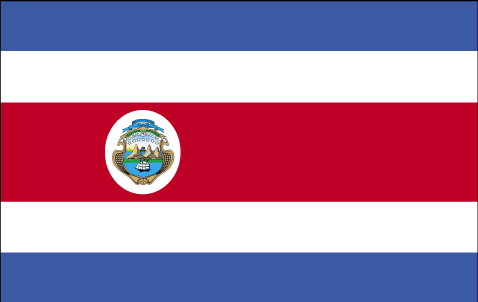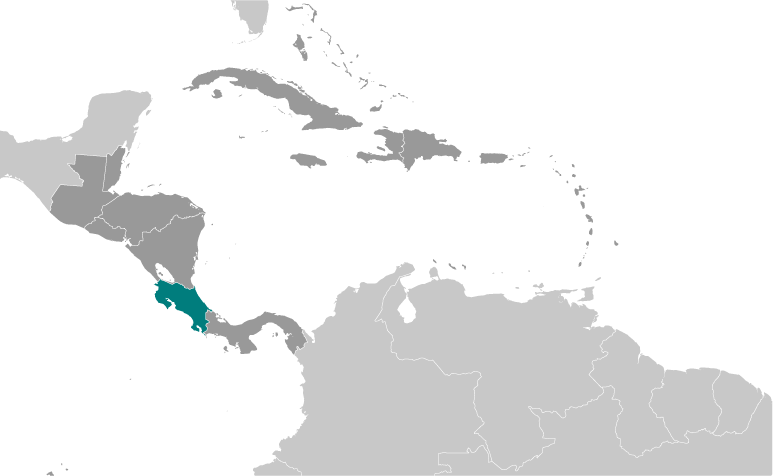
|
|
Advertisements:
EconomyEconomy - overview
Prior to the global economic crisis, Costa Rica enjoyed stable economic growth. The economy contracted 1.3% in 2009 but resumed growth at about 4% per year in 2010-11. While the traditional agricultural exports of bananas, coffee, sugar, and beef are still the backbone of commodity export trade, a variety of industrial and specialized agricultural products have broadened export trade in recent years. High value added goods and services, including microchips, have further bolstered exports. Tourism continues to bring in foreign exchange, as Costa Rica's impressive biodiversity makes it a key destination for ecotourism. Foreign investors remain attracted by the country's political stability and relatively high education levels, as well as the incentives offered in the free-trade zones; and Costa Rica has attracted one of the highest levels of foreign direct investment per capita in Latin America. However, many business impediments remain such as high levels of bureaucracy, legal uncertainty due to overlapping and at times conflicting responsibilities between agencies, difficulty of enforcing contracts, and weak investor protection. Poverty has remained around 15-20% for nearly 20 years, and the strong social safety net that had been put into place by the government has eroded due to increased financial constraints on government expenditures. Unlike the rest of Central America, Costa Rica is not highly dependent on remittances as they only represent about 2% of GDP. Immigration from Nicaragua has increasingly become a concern for the government. The estimated 300,000-500,000 Nicaraguans in Costa Rica legally and illegally are an important source of mostly unskilled labor but also place heavy demands on the social welfare system. The US-Central American-Dominican Republic Free Trade Agreement (CAFTA-DR) entered into force on 1 January 2009 after significant delays within the Costa Rican legislature. CAFTA-DR has increased foreign direct investment in key sectors of the economy, including the insurance and telecommunications sectors recently opened to private investors. President CHINCHILLA was not able to gain legislative approval for fiscal reform, her top priority. She has indicated she will continue to pursue fiscal reform in 2012. President CHINCHILLA and the PLN were successful in passing a tax on corporations to fund an increase for security services. Gdp (purchasing power parity) World Ranking: 90
$55.73 billion (2011 est.)
$53.5 billion (2010 est.) $51.11 billion (2009 est.) Note Data are in 2011 US dollars Gdp (official exchange rate)
$40.95 billion (2011 est.)
Gdp - real growth rate World Ranking: 90
4.2% (2011 est.)
4.7% (2010 est.) -1% (2009 est.) Gdp - per capita (ppp) World Ranking: 100
$12,100 (2011 est.)
$11,700 (2010 est.) $11,300 (2009 est.) Note Data are in 2011 US dollars Gdp - composition by sector
Agriculture 6.3%
Industry 21.7% Services 72% (2011 est.) Labor force World Ranking: 118
2.155 million
Note This official estimate excludes Nicaraguans living in Costa Rica (2011 est.) Labor force - by occupation
Agriculture 14%
Industry 22% Services 64% (2006 est.) Unemployment rate World Ranking: 71
6.5% (2011 est.)
6.9% (2010 est.) Population below poverty line
24.2% (2010 est.)
Household income or consumption by percentage share
Lowest 10% 1.2%
Highest 10% 39.5% (2009 est.) Distribution of family income - gini index World Ranking: 22
50.3 (2009)
45.9 (1997) Investment (gross fixed) World Ranking: 95
20% of GDP (2011 est.)
Budget
Revenues $5.761 billion
Expenditures $8.054 billion (2011 est.) Taxes and other revenues World Ranking: 199
14.1% of GDP (2011 est.)
Budget surplus (+) or deficit (-) World Ranking: 169
-5.6% of GDP (2011 est.)
Public debt World Ranking: 67
44.7% of GDP (2011 est.)
42.4% of GDP (2010 est.) Inflation rate (consumer prices) World Ranking: 120
4.9% (2011 est.)
5.7% (2010 est.) Central bank discount rate World Ranking: 6
21.5% (31 December 2010 est.)
23% (31 December 2009 est.) Commercial bank prime lending rate World Ranking: 29
16.15% (31 December 2011 est.)
17.091% (31 December 2010 est.) Stock of narrow money World Ranking: 75
$10.31 billion (31 December 2011 est.) $3.484 billion (31 December 2010 est.) Stock of broad money World Ranking: 84
$20.09 billion (31 December 2011 est.) $16.81 billion (31 December 2009 est.) Stock of domestic credit World Ranking: 85
$19.18 billion (31 December 2011 est.) $16.85 billion (31 December 2010 est.) Market value of publicly traded shares World Ranking: 101
$1.443 billion (31 December 2011) $1.445 billion (31 December 2010) $1.452 billion (31 December 2009) Agriculture - products
Bananas, pineapples, coffee, melons, ornamental plants, sugar, corn, rice, beans, potatoes; beef, poultry, dairy; timber Industries
Microprocessors, food processing, medical equipment, textiles and clothing, construction materials, fertilizer, plastic products Industrial production growth rate World Ranking: 107
2.8% (2011 est.)
Electricity - production World Ranking: 95
9.29 billion kWh (2008 est.)
Electricity - consumption World Ranking: 94
8.321 billion kWh (2009 est.)
Electricity - exports
166 million kWh (2008 est.)
Electricity - imports
70 million kWh (2008 est.)
Oil - production World Ranking: 113
263.4 bbl/day (2010 est.)
Oil - consumption World Ranking: 98
47,000 bbl/day (2010 est.)
Oil - exports World Ranking: 109
2,087 bbl/day (2009 est.)
Oil - imports World Ranking: 90
44,110 bbl/day (2009 est.)
Oil - proved reserves World Ranking: 120
0 bbl (1 January 2011 est.)
Natural gas - production World Ranking: 169
0 cu m (2009 est.)
Natural gas - consumption World Ranking: 167
0 cu m (2009 est.)
Natural gas - exports World Ranking: 83
0 cu m (2009 est.)
Natural gas - imports World Ranking: 177
0 cu m (2009 est.)
Natural gas - proved reserves World Ranking: 166
0 cu m (1 January 2011 est.)
Current account balance World Ranking: 147
-$2.2 billion (2011 est.)
-$1.274 billion (2010 est.) Exports World Ranking: 93
$10.38 billion (2011 est.)
$9.516 billion (2010 est.) Exports - commodities
Bananas, pineapples, coffee, melons, ornamental plants, sugar; beef; seafood; electronic components, medical equipment Exports - partners
US 33.9%, China 12.6%, Netherlands 12.1%, UK 10.7% (2011) Imports World Ranking: 83
$15.53 billion (2011 est.)
$12.96 billion (2010 est.) Imports - commodities
Raw materials, consumer goods, capital equipment, petroleum, construction materials Imports - partners
US 43.3%, Mexico 6.4%, China 6.2%, Japan 6% (2011) Reserves of foreign exchange and gold World Ranking: 91
$4.756 billion (31 December 2011 est.) $4.627 billion (31 December 2010 est.) Debt - external World Ranking: 94
$10.05 billion (31 December 2011 est.) $8.849 billion (31 December 2010 est.) Stock of direct foreign investment - at home World Ranking: 76
$15.55 billion (31 December 2011 est.) $13.5 billion (31 December 2010 est.) Stock of direct foreign investment - abroad World Ranking: 81
$144.7 million (31 December 2011 est.) $88.3 million (31 December 2010 est.) Exchange rates
Costa Rican colones (CRC) per US dollar - 505.66 (2011 est.)525.83 (2010 est.) 573.29 (2009) 530.41 (2008) 519.53 (2007) Fiscal year
Calendar year
Comments
Add a new comment: |
Advertisement
Members area
Costa Rica (San Jose):
 
GPS points from Costa Rica (San Jose)
|
||||||||

 Although explored by the Spanish early in the 16th century, initial attempts at colonizing Costa Rica proved unsuccessful due to a combination of factors, including: disease from mosquito-infested swamps, brutal heat, resistance by natives, and pirate raids. It was not until 1563 that a permanent settlement of Cartago was established in the cooler, fertile central highlands. The area remained a colony for some two and a half centuries. In 1821, Costa Rica became one of several Central American provinces that jointly declared their independence from Spain. Two years later it joined the United Provinces of Central America, but this federation disintegrated in 1838, at which time Costa Rica proclaimed its sovereignty and independence. Since the late 19th century, only two brief periods of violence have marred the country's democratic development. In 1949, Costa Rica dissolved its armed forces. Although it still maintains a large agricultural sector, Costa Rica has expanded its economy to include strong technology and tourism industries. The standard of living is relatively high. Land ownership is widespread.
Although explored by the Spanish early in the 16th century, initial attempts at colonizing Costa Rica proved unsuccessful due to a combination of factors, including: disease from mosquito-infested swamps, brutal heat, resistance by natives, and pirate raids. It was not until 1563 that a permanent settlement of Cartago was established in the cooler, fertile central highlands. The area remained a colony for some two and a half centuries. In 1821, Costa Rica became one of several Central American provinces that jointly declared their independence from Spain. Two years later it joined the United Provinces of Central America, but this federation disintegrated in 1838, at which time Costa Rica proclaimed its sovereignty and independence. Since the late 19th century, only two brief periods of violence have marred the country's democratic development. In 1949, Costa Rica dissolved its armed forces. Although it still maintains a large agricultural sector, Costa Rica has expanded its economy to include strong technology and tourism industries. The standard of living is relatively high. Land ownership is widespread.